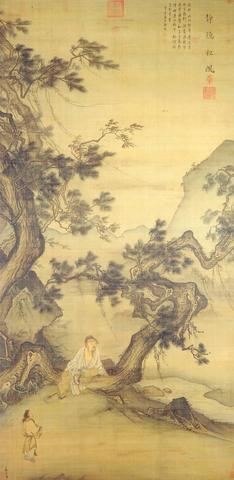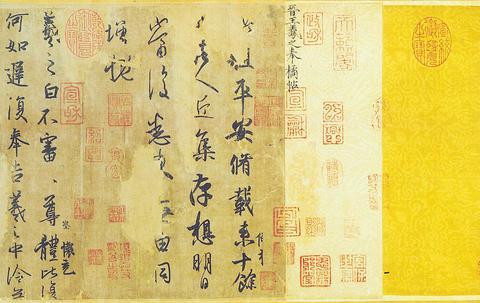The National Place Museum's complete collection of over 10,000 scrolls of calligraphy and painting has probably never been seen in its totality and many of the most precious items are hidden away for years on end, only allowed out on special occasions to be shown in dim rooms for limited periods of time.
Treasured Paintings and Calligraphic Works is a small exhibition that makes use of only three rooms on the second floor of the museum, but is worthwhile, as the works on display -- many of them nearly a thousand years old and extremely fragile -- may not go on display again for many years to come.
The show has works by major artists from the Tang (618 to 907), Sung (960 to 1279) and Yuan (1279 to 1368) dynasties and are accompanied by detailed notes in Chinese and English that add valuable insights into what is being looked at. One of the most amazing aspects of the show is the manner in which it highlights the transmission of art works through the ages.

PHOTO COURTESY OF NPM
This is most clearly visible in the Ping-an, Ho-ju and Feng-chu (平安何如奉橘帖) scroll which is a pre-Tang dynasty copy of the calligraphy of Wang Hsi-chih (王羲之, 307 to 365), regarded by many as China's greatest calligrapher. The scroll contains three examples of his work and there are detailed notes pointing out his mastery of different styles. The scroll also contains the many seals that records its transmission from one owner to another over the
centuries.
Another magnificent example of calligraphy is Essay on Calligraphy by Sun Kuo-ting, a work from around the 7th century which awes with its length -- 3,00 characters long, covering all the major styles up to that period -- which is not only a important historical document but also a work of art and endurance in itself.

PHOTO COURTESY OF NPM
There are also a number of paintings, with the father and son duo Ma Yuan (
Egrets on a Snowy Bank (
Solid English notes add considerably to the interest of this exhibition, making it much more that just looking at very old scrolls, though this too is part of the fascination. The scrolls will be on display until Nov. 10.

The canonical shot of an East Asian city is a night skyline studded with towering apartment and office buildings, bright with neon and plastic signage, a landscape of energy and modernity. Another classic image is the same city seen from above, in which identical apartment towers march across the city, spilling out over nearby geography, like stylized soldiers colonizing new territory in a board game. Densely populated dynamic conurbations of money, technological innovation and convenience, it is hard to see the cities of East Asia as what they truly are: necropolises. Why is this? The East Asian development model, with

June 16 to June 22 The following flyer appeared on the streets of Hsinchu on June 12, 1895: “Taipei has already fallen to the Japanese barbarians, who have brought great misery to our land and people. We heard that the Japanese occupiers will tax our gardens, our houses, our bodies, and even our chickens, dogs, cows and pigs. They wear their hair wild, carve their teeth, tattoo their foreheads, wear strange clothes and speak a strange language. How can we be ruled by such people?” Posted by civilian militia leader Wu Tang-hsing (吳湯興), it was a call to arms to retake

This is a deeply unsettling period in Taiwan. Uncertainties are everywhere while everyone waits for a small army of other shoes to drop on nearly every front. During challenging times, interesting political changes can happen, yet all three major political parties are beset with scandals, strife and self-inflicted wounds. As the ruling party, the Democratic Progressive Party (DPP) is held accountable for not only the challenges to the party, but also the nation. Taiwan is geopolitically and economically under threat. Domestically, the administration is under siege by the opposition-controlled legislature and growing discontent with what opponents characterize as arrogant, autocratic

When Lisa, 20, laces into her ultra-high heels for her shift at a strip club in Ukraine’s Kharkiv, she knows that aside from dancing, she will have to comfort traumatized soldiers. Since Russia’s 2022 invasion, exhausted troops are the main clientele of the Flash Dancers club in the center of the northeastern city, just 20 kilometers from Russian forces. For some customers, it provides an “escape” from the war, said Valerya Zavatska — a 25-year-old law graduate who runs the club with her mother, an ex-dancer. But many are not there just for the show. They “want to talk about what hurts,” she